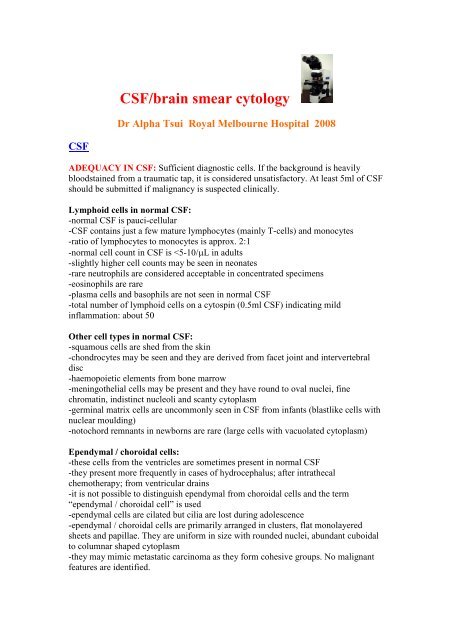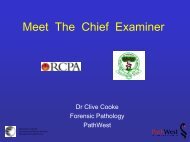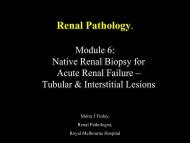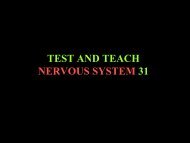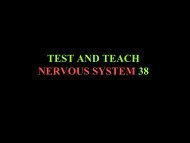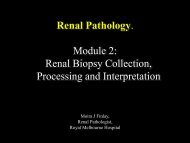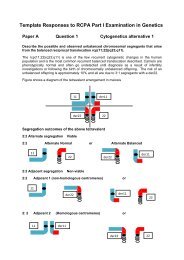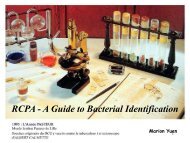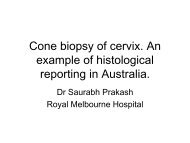CSF/brain smear cytology - Rcpa.tv
CSF/brain smear cytology - Rcpa.tv
CSF/brain smear cytology - Rcpa.tv
- No tags were found...
Create successful ePaper yourself
Turn your PDF publications into a flip-book with our unique Google optimized e-Paper software.
<strong>CSF</strong>/<strong>brain</strong> <strong>smear</strong> <strong>cytology</strong>Dr Alpha Tsui Royal Melbourne Hospital 2008<strong>CSF</strong>ADEQUACY IN <strong>CSF</strong>: Sufficient diagnostic cells. If the background is heavilybloodstained from a traumatic tap, it is considered unsatisfactory. At least 5ml of <strong>CSF</strong>should be submitted if malignancy is suspected clinically.Lymphoid cells in normal <strong>CSF</strong>:-normal <strong>CSF</strong> is pauci-cellular-<strong>CSF</strong> contains just a few mature lymphocytes (mainly T-cells) and monocytes-ratio of lymphocytes to monocytes is approx. 2:1-normal cell count in <strong>CSF</strong> is
Normal megakaryocytes:-single; never form cohesive groups-multinucleation: bag of eccentric nuclei-may have very bizarre irregular hyperchromatic nuclei-low N/C ratio with abundant cytoplasm-look for other cell types: myelocytes, normoblasts, etcVentricular fluid from shunt or reservoir:-frequently contain ependymal / choroidal cells in large numbers-fragments of normal grey and white matter containing neurons, astrocytes,oligodendrocytes, corpora amylacea and capillaries-more neutrophils and eosinophils, in response to ventricular wall irritationNormal neurons:-usually have prominent nucleoli-low N/C ratio-smooth nuclear membrane-cytoplasm may have Nissl substance-cytoplasmic processesBloody background:-usually implies traumatic tap (peripheral blood contamination)-may also be secondary to subarachnoid haemorrhage-problems:-entrapped inflammatory cells: does not mean meningitis-entrapped malignant (e.g. leukaemic) cells: does not necessarily mean meningealtumour involvement-not suitable for cell count-may take days to weeks for changes to resolve post traumatic tap-criteria for bloody background:-grossly bloody fluid in specimen tube-macroscopically bloody cytospin->90% of the cytospin covered by overlapping red blood cellsIncrease in neutrophil count:-bacterial meningitis-early stage of viral, TB or fungal meningitis-ischaemia-recent surgery-neoplasiaIncrease in lymphocyte count:-nonbacterial infections-multiple sclerosis-Guillain-Barré-syringomyelia-AIDSIncrease in eosinophil count:-drug reaction
-foreign material e.g. shunt-parasitic infection-some tumours e.g. lymphoma, Langerhans cell histiocytosisIncrease in macrophage count:-trauma-cerebral infarction-haemorrhage-sarcoidosis-demyelination-Whipple’s disease-vasculitis-treated lymphomaSpecific entities in the <strong>CSF</strong>:Reaction after subarachnoid haemorrhage:-proliferation of macrophages-phagocytosis of erythrocytes-enzymatic destruction of haemoglobin and ingested RBCs appear as emptycytoplasmic vacuoles in the macrophages-appearance of haemosiderin (after 4 days)-haemosiderin-laden macrophages may persist for more than 6 monthsInfectious conditions:-increased number of inflammatory cells, esp. polymorphs or activated lymphocytes,suggest infections-acute bacterial meningitis: infiltrate composed predominantly of polymorphs-viral meningoencephalitis: predominantly lymphocytic response-look for organisms (quantity, morphology, intra or extracellular)-needs microbiological culture for definitive diagnosisReactive lymphocytosis:-reactive and atypical lymphocytosis may be seen in multiple sclerosis, Guillain-Barrésyndrome, cryptococcal meningitis-activated lymphocytes and monocytes may become larger with multiple nuclei andprominent nucleoli, mimicking malignant cells-a heterogeneous population of lymphocytes may be difficult to appreciate if there arenot that many cells-clues:-heterogeneous population with lymphocytes of varying sizes; majority small andmature-intermixed with monocytes and plasma cells or neutrophils-cells do not have significant nuclear pleomorphism, coarsely clumped chromatin ormacronucleoli-look at the Pap stain (Diff-Quik exaggerates cell size)-immunostaining: most of the lymphocytes are T-cells-repeat sample and send fluid off for flow cytometryCryptococcus:
-yeast itself 7-10μm, surrounded by mucoid capsule up to 20μm-look for the capsule and budding yeasts-when intracellular, may look like intracytoplasmic vacuole-capsule-deficient form may be difficult to recognise (in AIDS patients). Yeasts muchsmaller (2.5μm)-DDx: erythrocytes; talc powder - polarise it with Maltese-cross pattern; corporaamylaceaChronic asceptic meningitis (Mollaret meningitis):-culture negative-aetiology unclear-characterised by initial neutrophilic response that progresses to a lymphocyticinfiltrate-Mollaret cells are large monocytes with abundant vacuolated cytoplasmLymphoma / leukaemia:-cannot distinguish lymphoma from leukaemia on <strong>cytology</strong> alone-some leukaemic cells tend to have convoluted, ‘horseshoe’ type nuclei-leukaemic cells may have more cytoplasm-myeloid cells have cytoplasmic granules, Auer rods-small numbers of malignant cells problematic (e.g. during chemotherapy)How to deal with small numbers of malignant lymphoid cells:-be sure that the cells have malignant criteria (nuclear pleomorphism beyond that seenin reactive cells, hyperchromasia, coarse chromatin, prominent irregular nucleoli)-look for specific differentiation e.g. cytoplasmic granules, Auer rods-compare and contrast with adjacent normal lymphoid cells-compare and contrast with previous <strong>cytology</strong>-immunostaining-flow cytometryMetastatic carcinoma:-tumours need to extend into the ventricular system or subarachnoid space +/-leptomeningeal involvement before shedding the cells into the <strong>CSF</strong>-this usually implies late stage disease and a diagnosis would have almost certainlybeen made in the past-commonly from lung, breast, stomach-greater tendency for cells to shed singly or in small loose clusters rather than incohesive tissue fragments (i.e. the tumour cells may look like melanoma orlymphoma)-in adenocarcinomas, glandular structures are rarely identified-can confirm mucinous vacuoles by mucin stains-keratinisation is also difficult to demonstrate. Look for dense cytoplasm, tadpolecells in squamous cell carcinomaIn a fluid milieu, any cell may become vacuolated and this does notnecessarily indicate adenocarcinoma.
Metastatic melanoma:-cells are large-coarse nuclear chromatin-prominent macronucleoli, binucleation, intranuclear pseudoinclusions-moderate amounts of cytoplasm, containing melaninAstrocytoma:-single cells or forming aggregates-fibrillary matrix made from the astrocytic cytoplasmic processes not shed in the <strong>CSF</strong>-cells vary from small to large in size-high N/C ratio with irregular hyperchromatic nuclei and scanty cytoplasm-may have gemistocytic form with moderate amounts of eosinophilic cytoplasm andeccentric nucleiMedulloblastoma:-shows a tendency for cell cohesion-cells show nuclear moulding, scant cytoplasm, hyperchromatic nuclei, mimicking asmall cell carcinomaChoroid plexus papilloma:-the tumour cells may be as bland as the normal choroid plexus cells-the <strong>smear</strong>s are much more cellular with numerous papillary clusters-the diagnosis is based on the finding of an intraventricular massFALSE POSITIVES:-degenerate cells-normal components: chondrocytes, ependymal / choroidal cells, bone marrowelements: megakaryocytes, immature myeloid elements-traumatic tap containing circulating tumour cells from peripheral blood-reactive lymphocytosis from various causes-foamy and vacuolated macrophages mimicking adenocarcinoma-haemosiderin-laden macrophages mimicking melanoma cells-viral inclusions-post-intrathecal treatment effectFALSE NEGATIVES:-often only small numbers of tumour cells are seen-necrotic tumours-low grade astrocytic tumours e.g. pilocytic astrocytoma-AML with monocytic differentiation mimicking benign monocytes
PRACTICAL TIPS:1. Know the cellularity of normal <strong>CSF</strong>. Any derivation is abnormal. Cells from <strong>CSF</strong>often become degenerate (looking atypical) if not processed quickly. Only assesswell-preserved cells.2. Beware starch granules or erythrocytes mimicking cryptococcus. Use polarisedlight.3. Bloody background with entrapped inflammatory cells is unsatisfactory. It shouldnot be assumed to represent true inflammation. Also beware traumatic tapcontaining circulating tumour cells. Need to repeat specimen in these instances.4. Reactive lymphocytosis with activated lymphocytes may mimic lymphoma. Lookfor heterogeneity of the cells. May need flow cytometry in difficult cases. Checkthe serum white cell count.5. Carcinomas often present as single cells, mimicking a melanoma or lymphoma.Need to do immunostains on a cell block to confirm unless there is a known pasthistory.
Fig 1. Normal <strong>CSF</strong>. Note hypocellularity.Fig 2. Normal chondrocytes.
Fig 3. Normal ependymal/choroidal cells. May be mistaken for a carcinoma.Fig 4. Normal ependymal/choroidal cells with columnar shaped cytoplasm.
Fig 5. Unsatisfactory. Degenerate cells with smudged nuclear detail.Fig 6. Bacterial meningitis with neutrophils and bacterial cocci.
Fig 7. Viral meningitis with lymphocytes and monocytes.Fig 8. Chronic asceptic meningitis with lymphocytes and vacuolated monocytes(Mollaret cell – Arrow).
Fig 9. Cryptococcus.Fig 10. Erythrophagocytosis, which may mimic cryptococcus.
Fig 11. Corpora amylacea, which resembles cryptococcus.Fig 12. Subarachnoid haemorrhage.
Fig 13. Metastatic carcinoma with single cell presentation.Fig 14. Metastatic squamous cell carcinoma, which often elicits prominent acuteinflammation.
Fig 15. Metastatic small cell carcinoma from the lung. Note nuclear moulding.Fig 16. Metastatic melanoma.
Fig 17. Non-Hodgkin lymphoma.Fig 18. Leukaemia (Acute myeloid leukaemia).
Fig 19. Leukaemia. Tumour cells usually show marked nuclear irregularity.Fig 20. Glioblastoma multiforme.
Fig 21. Brain fluid <strong>cytology</strong>: Glioblastoma multiforme.
Brain <strong>smear</strong>s:Normal:Normal cerebral cortex:-abundant neurons that are uniformly distributed-oligodendroglial cells with small round nuclei-microglial cells with small elongated nuclei-fibrillary background, branching meshwork of thin-walled capillariesNormal deep cerebral grey matter:-larger neurons often prominent-calcospherites may be seen in older patientsNormal white matter:-background neuropil is typically coarser and more fibrillary than that of grey matterbecause of greater proportion of myelinated fibres-mixture of oligodendroglial, microglial and astrocytic nuclei-less vascular-normal glial cell nuclei are small with no perinuclear cytoplasmNormal cerebellar cortex:-the granular layer of the normal cerebellar cortex is one of the most cellular regionsof the CNS-<strong>smear</strong>s show hypercellular zones in a fibrillary background-most numerous cells are granule cells: round nuclei with central chromatin aggregate(targetoid appearance). Size of the nucleus is about that of a normal lymphocyte.-Purkinje cells: very large cell with pyramidal or bulbous shape cell body, 1-2prominent nucleoli, abundant granular cytoplasm, thick dendritic processes extendingfrom the cell bodySmears from normal cerebellar cortex may mimic a small round celltumour, esp. medulloblastoma. Normal granule cells are smaller and they do notmould. Purkinje cells are intermixed with the granule cells.Normal pituitary gland:-tougher to <strong>smear</strong>-cytological heterogeneity with cells of different sizes and nuclear patternNon-neoplastic lesions:Reactive gliosis:-<strong>smear</strong>s are cellular than normal-cells show even distribution with no nuclear crowding-astrocytes have long radiating processes and stellate cytoplasm (neoplastic astrocytesdo not have long processes)-beware: mitoses may be seen but morphologically normal and usually sparse-background neuropil tends to be more coarsely fibrillary than normal-characterised by evenly spaced astrocytes of uniform size with abundant eosinophiliccytoplasm and radiating long processes-if there are foamy macrophages or perivascular lymphocytes, a reactive processshould be first considered
-Rosenthal fibres and eosinophilic granular bodies may be presentInfarct:-most distinctive feature is presence of many foamy macrophages-ischaemic red neurons may be present (pyknotic nuclei, dense hypereosinophiliccytoplasm)-elongate fibroblastic cells and rod-shaped nuclei of activated microglia seen-mitoses and endothelial cell proliferation (at the periphery of organising infarct) maybe presentSignificant number of foamy macrophages goes against a diagnosis ofastrocytoma. Foamy macrophages may mimic gemistocytes. Look carefully forthe typical macrophage nucleus and cytoplasmic foaminess.Demyelination:-occurs in the white matter, not the cortex as in an infarct-<strong>smear</strong>s are often difficult to be distinguished from infarction-reactive astrocytes and foamy macrophages are seen-lymphocytic infiltrate may be prominent in some cases-no ischaemic red neurons-necrosis is rareOrganising abscess:-there are polymorphs, lymphocytes, plasma cells, histiocytes, along with necroticdebris-plump reactive astrocytes in the background-may see bacteria, fungiArterio-venous malformation:-abundant hypertrophic blood vessels intermingled with reactive <strong>brain</strong> tissue-abundant haemosiderin-cells do not show significant atypiaSequestrated disc prolapse:-eosinophilic, granular material with few cells (may mimic necrosis but there is nocellular debris)Lymphocytic hypophysitis:-rubbery tissue, tough to <strong>smear</strong>-scattered lymphocytes and plasma cells-smaller numbers of neutrophils, eosinophils, histiocytesBeware a lurking germinoma, esp. if granulomas are also present.Submit all the tissue for frozen section.Astrocytic tumours:Diffuse astrocytoma:-more hypercellular than normal but can be similarly cellular as in reactive gliosis
-more monotonous rather than varied mixture of cells-tumour cells show crowding, forming cellular aggregates-obvious cytological atypia with nuclear enlargement, hyperchromasia, irregularnuclear membrane, coarse chromatin-cells are seen around blood vessels-bare atypical nuclei may be present-some cells may have gemistocytic formGlioblastoma multiforme:-neoplastic astrocytes have marked nuclear pleomorphism, hyperchromasia andvariable cytoplasm with fibrillary matrix in the background-tumour giant cells may be seen-look for mitoses, endothelial cell proliferation, necrotic vessels, necrosis-significant acute inflammation with neutrophils is not a feature of GBM and is moresuggestive of an infectious process-necrotic vessels are more often seen in GBM than in an infarct-necrotic tumour cells may continue to cling to the ghost blood vesselsEndothelial cell hyperplasia is seen in high grade astrocytomas but rarelypresent in metastatic carcinomas. Endothelial cell proliferation may also be seen atthe edge of an organising infarct (look for foamy macrophages and inflammatorycells).Features favouring a primary high grade astrocytic tumour over metastasis:fibrillary matrix; cells with ill-defined cytoplasmic borders; endothelial cellproliferation; no evidence of specific differentiation e.g. glands, keratinisation,Gliosarcoma:-features of GBM and malignant mesenchymal component (present as pleomorphicspindle cells)-spindle cells form cellular bundles / fascicles-heterologous elements rarely seenPilocytic astrocytoma:-beware of this diagnosis in young patients and typical location e.g. cerebellum,<strong>brain</strong>stem, around optic nerve, spinal cord-cells cluster around blood vessels and may form ill-defined fascicles with processesin parallel arrays-cells have elongated rod-shaped nucleus, scanty cytoplasm and bipolar cytoplasmicprocesses-multinucleated cells are a clue (nuclei forming a ring)-can have marked degenerative atypia (with smudged chromatin, intranuclearinclusions), mistaken for high grade glioma-endothelial cell proliferation may be present-mitoses and necrosis not a feature-look for Rosenthal fibres and granular bodiesPleomorphic xanthoastrocytoma:-cells are markedly pleomorphic-characteristic feature is lipid droplets in the tumour cytoplasm-the tumour cells may be elongated and may form vague fascicles
-no mitoses, endothelial proliferation and necrosis-granular bodies may be seen-there may be perivascular cuffing of lymphocytesSubependymal giant cell astrocytoma:-cells with abundant cytoplasm with processes, large vesicular nuclei, prominentnucleoli-some of the cells are more spindled-no mitoses, vascular proliferation or necrosis-calcospherites are often presentOligodendroglial tumours:Oligodendroglioma:-tendency to spread apart in <strong>smear</strong>s forming monolayer sheets with little evidence ofcellular aggregation-no fibrillary background-fine branching capillary network-nuclear pleomorphism is not prominent-round nuclei-cells have no processes-calcification-oligoastrocytoma: neoplastic astrocytes with cell processes, more denselyeosinophilic cytoplasm, patchy gliofibrillary matrixPerinuclear haloes are not seen in <strong>cytology</strong>. They represent tissuefixation and processing artefact.Ependymal tumours:Ependymoma:-most important clue is formation of perivascular pseudorosettes-the nuclei are orientated away from the axis of the vessel and a characteristic fibrillarzone separates them from the vessel wall-prominent fibrillary matrix in the background-nuclei are larger and rounder than those in astrocytomas-true ependymal rosettes are rareMyxopapillary ependymoma:-fibrillar matrix is replaced by myxoid matrix-myxoid material best seen with Diff-Quik stain (magenta-coloured)-myxoid material presents as globules or contained within vessel wallSubependymoma:-tumour is generally too tough to make a monolayered <strong>smear</strong>-shows thick masses of fibrillary tissue-tumour cells show elongated nuclei and scanty cytoplasm-calcification commonChoroid plexus tumours:Choroid plexus papilloma:
-well-defined papillary masses with central vascular cores-generally more cellular than normal, several layers of cells surrounding papillarystructures-blood vessels lack the characteristic serpiginous outline seen in normal plexus tissue-central blood vessels less prominent as compared with those in normal <strong>smear</strong>s-nuclei are small, round and uniform-no fibrillary matrix-calcospherites and haemosiderin commonly presentChoroid plexus carcinoma:-presence of many mitoses is a clue (mitoses not seen in papillomas)-less organised papillary architecture-more cellular pleomorphism-proliferation of blood vessels-necrosisDiagnosis of choroid plexus carcinoma should be made withextreme caution in adults. Metastatic adenocarcinoma should beconsidered first: look for acini, goblet cells, mucin production.Neuronal and mixed neuronal-glial tumours:Ganglioglioma / gangliocytoma:-cells have a tendency to form large clusters around blood vessels-large neurons with binucleate or multinucleate forms-may contain a mixture of ganglion cells, astrocytes and perivascular lymphocytes-the pleomorphic glial component may be more conspicuous and mistaken for a highgrade astrocytomaCentral neurocytoma:-sheets of dyscohesive cells with round nuclei, granular chromatin and scantcytoplasm-background of fine fibrillary material-may have multi-branching vessels-calcospherites often seen-diagnosis is made when the intraventricular location of the lesion is known (<strong>cytology</strong>is almost identical to that seen in oligodendroglioma)Dysembryoplastic neuroepithelial tumour (DNET):-increased numbers of oligodendroglial-like cells with round nuclei, surrounded bymucoid matrix and prominent blood vessels-floating neurons of normal morphology may be present-reactive astrocytes in the backgroundDysplastic gangliocytoma of cerebellum:-diffuse enlargement of the molecular and internal granular layers of the cerebellumby dysplastic ganglion cells-these ganglion cells have enlarged vesicular nuclei with prominent nucleoli-there are scattered granule cells which are mildly enlarged-Purkinje cells are absent or reduced in number
Pineal region tumours:Pineocytoma:-monotonous population of small round cells-rosettes can be seen-cells show round to oval nuclei, no nuclear pleomorphism, inconspicuous nucleoli,moderate amounts of cytoplasm with short processes-fibrillary matrix and calcification in the background-no necrosisPineoblastoma:-tumour cells with high N/C ratio, coarse chromatin and prominent nucleoli-rosettes not generally seen-mitoses, necrosis presentEmbryonal tumours:Medulloblastoma and PNET:-densely packed cells with oval or carrot-shaped nuclei showing nuclear moulding-mitoses often seen-rosettes may be identifiedCranial and paraspinal nerve tumours:Schwannoma:-hard edge groups-characteristic twisted rope pattern: cords of spindle cells becoming entwined together-clean background: not a lot of dyscohesive single cells-beware: background may be coarsely fibrillary (do not overcall as astrocytoma)-spindle cells with axial orientation-nuclei are ovoid with rounded ends-haemosiderin, foamy macrophages, thick-walled vessels helpful features-ancient change: pleomorphic cells with smudged chromatin and intranuclearinclusionsMajor differential diagnosis of schwannoma is fibrous meningioma.Features favouring schwannoma: paucity of single cells; secondary changes– haemosiderin, thick-walled vessels, foamy macrophages.Neurofibroma:-tend not to show the twisted rope pattern-generally less cellular than a schwannoma-cells with elongated, wavy nuclei and ill-defined cytoplasm-variable collagenous and myxoid backgroundMalignant peripheral nerve sheath tumour:-markedly cellular with clusters, fascicles and single malignant spindle to epithelioidcells-there may be pleomorphic and multinucleated tumour cells-scattered mitoses
Tumours of meningothelial cells:Meningioma:-more single cells in the background, as compared to schwannoma-whorls, syncytial groups, fascicles-cells may look 'epithelioid', mimicking a carcinoma but they are very uniform in size-round to oval nuclei, intranuclear inclusions, indistinct nucleoli-psammoma bodiesAtypical meningioma:-some cells may show nuclear atypia: high N/C ratio with small cells; prominentnucleoli-mitoses and necrosis may be seenAnaplastic (malignant) meningioma:-there is usually a loss of meningothelial differentiation, in which the cells resemble acarcinoma, melanoma or sarcomaMesenchymal tumours:Haemangiopericytoma:-cohesive groups with irregular edges and single cells-tumour cells with high N/C ratio, hyperchromatic ovoid nuclei, small nucleoli andscanty cytoplasmPrimary melanocytic lesions:Malignant melanoma:-single cells-large eccentric, pleomorphic nuclei with prominent nucleoli-binucleation, intranuclear pseudoinclusions-cytoplasmic pigmentOther tumours related to the meninges:Haemangioblastoma:-<strong>smear</strong>s poorly-densely vascular thick clumps of cells-oval medium-sized nuclei, indistinct cytoplasm-the typical vascular network is poorly visualized on the <strong>smear</strong>s-presence of mast cells is a clue to the diagnosisHaematopoietic tumours:Lymphoma:-the blood vessel walls are often infiltrated by tumour cells (rather than endothelialcell hyperplasia)-single cells with high N/C ratio, prominent nucleoli, scant cytoplasm-lymphoglandular bodies may be seenPlasmacytoma:-uniform population of single neoplastic plasma cells-plasmacytoid differentiation: eccentric nuclei, ‘clockface’ chromatin, perinuclear hof-bi and multinucleated forms may be present-some cells may show blastic features with prominent nucleoli
-Dutcher (intranuclear) and Russell (extra/intracytoplasmic) bodies seen-amyloid may be seen in some casesGranulocytic sarcoma:-hypercellular infiltrate of single tumour cells-appearances depending on type of leukaemia-cells generally have more convoluted nuclei and slightly more cytoplasm, ascompared with lymphoma-may see cytoplasmic granules and Auer rods with myeloid cellsLangerhans cell histiocytosis:-single tumour cells with enlarged bean-shaped nuclei and intranuclear grooves-prominent eosinophils in the backgroundGerm cell tumours:Germinoma:-cohesive and single tumour cells-cells with pleomorphic nuclei, prominent nucleoli and moderate amounts ofcytoplasm-tigroid background (best seen with Diff-Quik stain)-fibrous septa with lymphocytes are seen, with tumour cells clinging onTumours of the sellar region:Craniopharyngioma:-may have cystic component which is thick dark brown (machinery oil-like) withminute glistening crystals of cholesterol-cohesive epithelial groups with squamous cells, some showing ‘stellate-reticulum’appearance-wet-keratin may be seen with clumps of densely keratinised cells showing loss ofnuclear staining-calcification, cholesterol clefts, chronic inflammation in the backgroundPituitary adenoma:-softer to <strong>smear</strong> with smooth monolayer-cells usually dyscohesive-may have papillary structures with tumour cells clinging to branching vessels-single population of cells-finely granular chromatin, no nucleoli-no cytoplasm, bare nuclei - more likely to be non-functioning adenomas-with cytoplasm - more likely to be functioning types-functioning adenomas often contain pleomorphic tumour cells (e.g. GH, TSH, ACTHsecreting adenomas)-in prolactinomas with Bromocriptine effect, the tumour cells look similar to smallcell lymphoma (esp. on frozen section)-prolactinomas often contain psammoma bodiesGranular cell tumour:-clusters and single cells with abundant granular cytoplasm, prominent nucleoli-nuclear atypia such as nuclear pleomorphism can be seen-cytoplasm usually not as spindled as in spindle cell oncocytoma
-the cytoplasmic granules stain red with Pap-the cytoplasm usually remains intact as compared with often stripped cytoplasm innon-functioning pituitary adenomasSpindle cell oncocytoma of the anterior hypophysis:-aggregates of spindle cells with elongated tapering granular cytoplasm-cells have ovoid nuclei, conspicuous nucleoli-background of lymphocytes and plasma cells typical (hypophysitis)Chordoma:-cohesive groups, cords and single epithelioid cells with eosinophilic cytoplasm-physaliphorous cells with vacuolated cytoplasm-nuclear pleomorphism is usually mild-prominent mucoid material in the backgroundMetastatic tumours:Metastatic carcinoma:-cohesive groups, papillae, acinar structures, depending on the subtype-cells have well-defined cytoplasmic boundary (poorly defined in astrocytomas)-no fibrillary background-no true endothelial cell proliferation-look for evidence of differentiation e.g. glands, signet-ring cells, mucin,keratinisation, neuroendocrine type featuresFALSE POSITIVES:-normal cerebellar cortex (granule cells) mimicking a small round cell tumour-reactive gliosis difficult to distinguish from a low grade astrocytoma-foamy macrophages (e.g. infarct, demyelination) mistaken for neoplasticgemistocytes-meningiomas can have “epithelioid” cells, mimicking a carcinoma-organising pyogenic abscess / infarct with a rim of endothelial cell hyperplasia-progressive multifocal leukoencephalopathy with reactive astrocytosis-viral encephalitis mimicking a lymphoma-viral inclusions mistaken for malignant epithelioid cells-pineal glial cyst mimicking a pineocytoma or astrocytomaFALSE NEGATIVES:-sampling error by the surgeon (reactive gliosis around the tumour is sampled) ortissue taken by a pathologist for a <strong>smear</strong> which is not representative-some tumours are hard to <strong>smear</strong> and the tumour cells are difficult to assess withindense tissue clumps e.g. haemangioblastoma (need to correlate with frozen section)-low grade tumours: astrocytomas, lymphomas-necrotic tumours
PRACTICAL TIPS:1. Know cellularity of normal cerebral cortex, white matter, cerebellar cortex.2. In reactive astrocytosis, cells are evenly distributed and they have longcytoplasmic processes.3. Occasionally, the <strong>cytology</strong> or histology does not match the radiological findings.In some of these cases, reactive gliosis around the edge of a tumour is sampledrather than the tumour itself.4. Look for fibrillary matrix in an astrocytic tumour. However, background may lookfibrillary in other lesions e.g. meningioma, schwannoma5. If abundant neutrophils are seen, the lesion is more likely to be an infective processthan a tumour. Must submit tissue for microbiology. Necrotic areas from GBMrarely contain neutrophils.
Normal GBM Lymphoma Carcinoma Meningioma SchwannomaFig 1. Normal <strong>brain</strong> <strong>smear</strong>s smoothly as a monolayer. There may be small clumps inGBM, lymphoma and carcinoma. More difficult to <strong>smear</strong> in meningioma andschwannoma with larger aggregates.Fig 2. Normal cerebral cortex.
Fig 3. Normal neuron.Fig 4. Normal white matter with glial cells.
Fig 5. Normal cerebellar cortex with granule cells (may mimic small round celltumour).Fig 6. Normal cerebellar cortex with granule cells and Purkinje cell (Arrow).
Fig 7. Reactive gliosis with increased cellularity.Fig 8. Reactive gliosis.
Fig 9. Reactive gliosis. Astrocytes with no nuclear pleomorphism.Fig 10. Reactive astrocytes with long radiating cytoplasmic processes.
Fig 11. Ischaemic (red) neuron with pyknotic nucleus and dense eosinophiliccytoplasm.Fig 12. Cerebral abscess with neutrophils.
Fig 13. Toxoplasma cyst containing bradyzoites (Arrow).Fig 14. Demyelination showing foamy macrophages and reactive astrocytes.
Fig 15. Sequestrated intervertebral disc material with clumped nucleus pulposus.Fig 16. Pilocytic astrocytoma. Bipolar astrocytes in parallel arrays.
Fig 17. Pilocytic astrocytoma. Note eosinophilic granular bodies (Arrow).Fig 18. Fibrillary astrocytoma. The neoplastic astrocytes are unevenly distributed andthey have enlarged hyperchromatic nuclei.
Fig 19. Gemistocytic astrocytoma.Fig 20. Astrocytoma with protoplasmic astrocytes showing round nuclei.
Fig 21. Pleomorphic xanthoastrocytoma with scattered pleomorphic tumour cells.Fig 22. Pleomorphic xanthoastrocytoma. Note eosinophilic granular body (Arrow).
Fig 23. Pleomorphic xanthoastrocytoma. Note perivascular lymphocytes (Arrow).Fig 24. GBM with fibrillary matrix.
Fig 25. GBM: endothelial cell hyperplasia (Arrow).Fig 26. GBM: Necrotic blood vessel.
Fig 27. GBM: Necrosis.Fig 28. Gliosarcoma.
Fig 29. Subependymal giant cell astrocytoma.Fig 30. Oligodendroglioma. Tumour cells with round nuclei. Absence of fibrillarymatrix.
Fig 31. Oligodendroglioma. Chicken-wire vascular network.Fig 32. Oligodendroglioma. Calcification (Arrow).
Fig 33. Ependymoma. Note rosette (Arrow) and fibrillary matrix.Fig 34. Ependymoma. Perivascular pseudorosette with fibrillary zone between vesselwall and nuclei (Arrow).
Fig 35. Myxopapillary ependymoma. Magenta-staining myxoid globule.Fig 36. Myxopapillary ependymoma. Magenta-staining myxoid material within vesselwall.
Fig 37. Subependymoma with neoplastic cells showing elongated nuclei.Fig 38. Choroid plexus papilloma.
Fig 39. Choroid plexus papilloma with bland tumour cells.Fig 40. Ganglioglioma. Neoplastic ganglion cells with prominent nucleoli.
Fig 41. DNET. Floating neuron with surrounding oligodendroglial-like cells.Fig 42. Dysplastic gangliocytoma of cerebellum. Increased numbers of abnormalganglion cells, associated with granule neurons.
Fig 43. Central neurocytoma with a <strong>smear</strong>ing pattern similar to that of pituitaryadenoma. It’s essential to know the tumour location.Fig 44. Pineocytoma. Note rosette (Arrow).
Fig 45. PNET showing cells with elongated nuclei and nuclear moulding.Fig 46. Schwannoma. Hard-edged groups with no single cells in the background.
Fig 47. Schwannoma. Twisted rope pattern.Fig 48. Schwannoma. Verocay bodies.
Fig 49. Schwannoma with ancient change. Tumour cells with smudged chromatin andintranuclear inclusions.Fig 50. Neurofibroma.
Fig 51. Neurofibroma.Fig 52. Meningioma with whorls.
Fig 53. Fibrous meningioma with fascicles of spindle cells.Fig 54. Psammomatous meningioma.
Fig 55. Clear cell meningioma.Fig 56. Atypical meningioma. Tumour cells with nuclear enlargement. Note mitosis.
Fig 57. Haemangiopericytoma with cohesive groups and single cells.Fig 58. Haemangioblastoma. The tumour <strong>smear</strong>s poorly into thick fragments, giving afalse impression of a highly cellular tumour.
Fig 59. Haemangioblastoma. The typical vascular network is often difficult tovisualise on the <strong>smear</strong>s.Fig 60. Pineal germinoma. Note fibrous septa with lymphocytes (Arrow).
Fig 61. Normal anterior pituitary gland. Note heterogeneity of cell types, size andstaining properties.Fig 62. Pituitary adenoma.
Fig 63. ACTH secreting pituitary adenoma. Note prominent nuclear pleomorphism.Fig 64. Adamantinomatous craniopharyngioma with squamous epithelium showingstellate reticulum-like appearance.
Fig 65. Adamantinomatous craniopharyngioma with wet-keratin (Arrow).Fig 66. Granular cell tumour.
Fig 67. Spindle cell oncocytoma of the adenohypophysis.Fig 68. Langerhans cell histiocytosis. Tumour cells with bean-shaped nuclei andintranuclear grooves.
Fig 69. Chordoma. Bland appearing cells in mucoid background.Fig 70. Metastatic non-small cell carcinoma. Note absence of fibrillary matrix.
Fig 71. Metastatic carcinoma. Tumour cells with well-defined cytoplasmic border.Absence of fibrillary matrix in the background.Fig 72. Metastatic melanoma.
ReferencesYachnis AT. Intraoperative consultation for nervous system lesions. Sem Diag Pathol2002;19(4):192-206.Moss TH et al. Intra-operative diagnosis of CNS tumours. Arnold publishers. 1997.Joseph JT. Diagnostic neuropathology <strong>smear</strong>s. LWW. 2007.Torzewski M et al. Integrated <strong>cytology</strong> of cerebrospinal fluid. Springer. 2008.Kluge H et al. Atlas of <strong>CSF</strong> <strong>cytology</strong>. Thieme. 2007.


